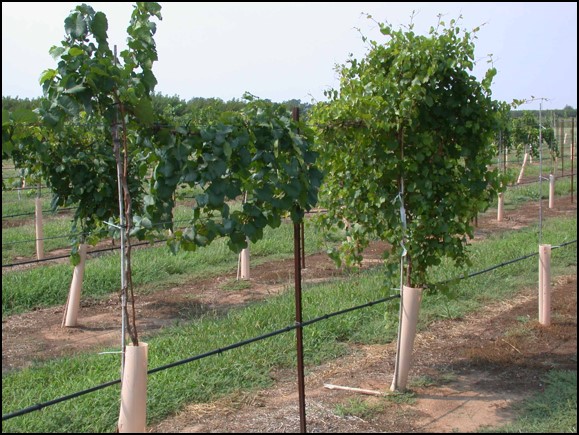Eric T. Stafne, Extension and Research Professor, Mississippi State University
Fall is coming soon, and winter is just around the corner. With the cold temperatures coming, it is important that grapevines are prepared. Irrigation should be stopped in September to allow plants to acclimate to the lower light conditions and cooler temperatures. Vines native to North America tend to do this better than Vitis vinifera types. For example, American grapes, such as ‘Concord’ or ‘Cynthiana’ will tend to start responding to shorter daylengths as well as cooler temperatures to prepare for dormancy. European grapes like ‘Chardonnay’ and ‘Merlot’ respond primarily to cooler temperatures. Therefore, American grapes get a head start on dormancy, whereas European grapes are at higher risk of being damaged in an early fall freeze event. While this is not usually much of a problem in certain areas of the south, vines in the upper and mid-South regions can be susceptible.
An important task to do is to remove grow tubes from around plants (Photo 1). Many grape growers use these during the growing season to protect plants from herbicide damage and sunscald, but also to speed up the growth of the plant. They work great during the growing season, but if left on during fall they will not allow the plant to acclimate normally. Tubes heat up with the sunlight and creates a small microenvironment that will be warmer than the outside air. However, once night arrives, the temperature inside the tube equals that of the outside air. The extreme changes from day to night temperatures can cause damage. This is also true during the winter.
Another thing that should not be done is fertilizing grapevines too late in the season. Nitrogen fertilizer will induce growth of green, succulent tissue that cannot acclimate quickly enough in the fall and thus will not go fully dormant. Often this growth is damaged or killed during the winter and can predispose the plant to stress and pest infestations.
Ultimately, the best thing to do to prepare grapevines for winter is to keep them healthy and happy throughout the year by planting them on a good site, provide adequate water, control insects and diseases, fertilize when necessary, train and prune appropriately, crop load thin if needed, and clean out debris that may be a source of fungal disease inoculum for future years.
Preparing for winter is just as important as managing for a good harvest. Just because the crop is off the vines doesn’t mean the vines don’t require some attention.
